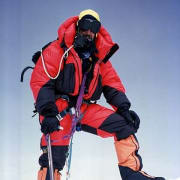Remains Found on Mt. Everest Intensify Mountaineering's Greatest Mystery

One of the greatest mysteries in mountaineering history has taken a step closer to resolution. Grayson Schaffer’s recent article in National Geographic revealed that it appears the body of Andrew ‘Sandy’ Irvine has been found on the north face of Mt. Everest. Mt. Everest's North Face has a rich and colorful history. Attempts on Mt. Everest from the north side began in the 1920's by British teams first led by George Mallory, but to no avail. Most significant was Mallory's 1924 British Expedition with Andrew “Sandy” Irvine. Mallory and Irvine died on this historic climb, and their actual achievement remains mountaineering's most intriguing mystery.
George Mallory’s body was found in 1999 below Mt. Everest's summit by an American team led by Eric Simonson of International Mountain Guides. No one knows if Mallory and Irvine died while ascending to the summit, or while descending after successfully summiting Mt. Everest. If Irvine and Mallory succeeded, their feat would have occurred 29 years before Tenzing Norgay and Edmund Hillary first reached the top of Everest. Climbers are still searching for Mallory's missing camera that could unlock the century-old mystery. With the discovery of Irvine’s remains, the mystery intensifies.
In September, a National Geographic documentary team that included photographer and director Jimmy Chin, along with filmmakers and climbers Erich Roepke and Mark Fisher discovered a boot emerging from melting ice. Inside the boot they discovered a sock and a foot, which they instantly recognized as belonging to Andrew Comyn Irvine (“Sandy”) who vanished 100 years ago with the famed climber George Mallory. “I lifted up the sock,” Chin says, “We were all literally running in circles dropping F-bombs.”
Chin hopes the discovery helps solve the mystery of the 1924 expedition, and brings closure to Irvine’s relatives. “When someone disappears and there’s no evidence of what happened to them, it can be really challenging for families. And just having some definitive information of where Sandy might’ve ended up is certainly [helpful], and also a big clue for the climbing community as to what happened.”
Early on the morning of June 8, 1924, the two men set off for the summit under conditions that Mallory is said to have described as ''perfect weather for the job.'' That afternoon, they were last spotted by teammate Noel Odell, who reported briefly noticing two tiny figures near the Second Step during a brief parting of the clouds. Then they were gone.
Chin received permission from the China-Tibet Mountaineering Association (CTMA), the governmental authority that oversees the north side of Everest, to remove the remains off the mountain. Chin carried the boot and foot off Everest in a cooler and turned it over to the CTMA. His team also took a DNA sample definitive identification. “But I mean, dude,” says Chin. “There's a label on it.”
While there are many discovered and named climbing routes on Everest, two routes are most commonly climbed: The South Col route starting from Nepal, and the Northeast Ridge Standard, or The North Col route, starting from Tibet. Mt. Everest was first summited by Sir Edmund Hillary and Tenzing Norgay in 1953 via The South Col route.
Since their historic accomplishment, their path has been the most traveled. This is mainly due to the Chinese invasion of Tibet in 1950, when they shuttered access to Mt. Everest, via Tibet, to all foreigners until 1980. Since then, attaining permits to the Northeast Ridge has been a challenge, resulting in far fewer climbs through Tibet's gates.
Elite climber Phil Ershler made the first American ascent of Mt. Everest's North Face on October 20, 1984. On that day, Phil and John Roskelley left high camp very late in the season and climbed through the Yellow Band where Roskelley turned back. Phil continued solo on steep terrain to the top, where his only bottle of oxygen ran out. He returned safely, and made history on Mt. Everest's north side.
